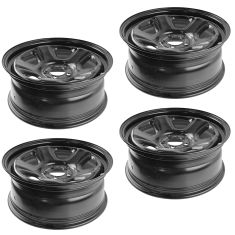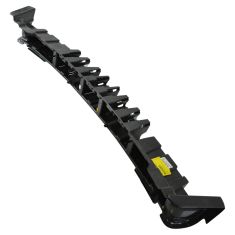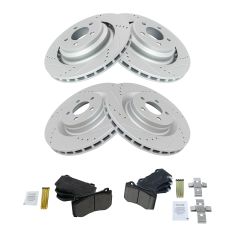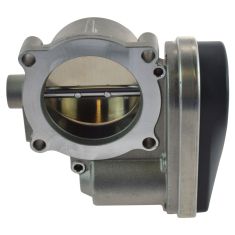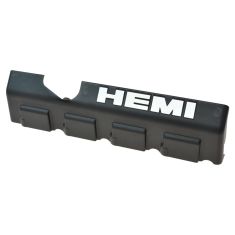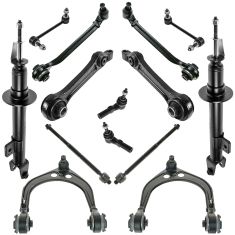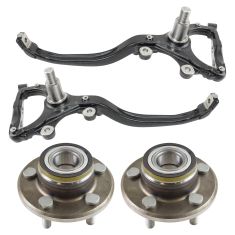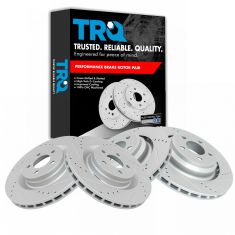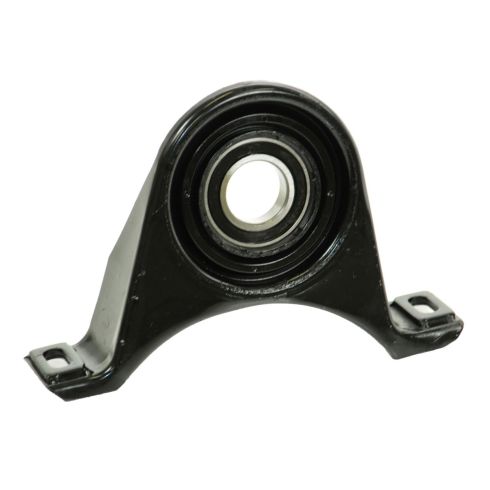Hi, I'm Mike from 1A Auto. We've been selling auto parts for over 30 years. We're dedicated to delivering quality auto parts, expert customer service, fast and free shipping, all backed by our 100% satisfaction guarantee. Visit us at 1AAuto.com, your trusted source for quality auto parts.
In this video, we're going to be working with our 2006 Chrysler 300. We're going to show you how to remove and replace your vehicle's center support bearing. This is for the middle of the two-piece driveshaft on our 3.5 liter V6 rear wheel drive model, however the procedure should be the same for other engine options, as well as other drive options. If you like this video, please click subscribe. We have a ton more information on this and many other vehicles, and if you need this part for your car, you can follow the link down in the description over to 1AAuto.com. Here are the items you'll need for this repair.
Unplug both of your downstream O2 sensors. The driver side connector is hanging here on the side of the transmission. Make sure it hangs freely. The passenger one connects right here at the transmission cross member. On the driver side of the exhaust there's a heat shield that we'll need to remove. There's a 13 mm on the end on each side that we'll take off with our socket, ratchet and extension. Depending on your exhaust you may need to use a universal joint. Remove the heat shield and then there's a 16 mm nut on each side that we'll remove with our 16 mm socket and ratchet. We'll repeat this step on the opposite side.
So, all the way at the back of the exhaust, we'll undo the 13 mm bolt securing this exhaust hanger bracket on each side. Now this is an aftermarket exhaust so you may just be able to slide yours out that bushing, but for these we're going to have to remove that bolt and the bracket of each side.
We'll then spray these down with some penetrating oil and remove the upper part of this stud. This side's a lot harder because of how tightly it's wrapped. Again, this is aftermarket so yours may slide out on the bottom but we'll do the top. Remove the four 13 mm nuts securing this cross member while having a friend support half the exhaust, at which point both of you can lower it down from the vehicle. These rubber hangers can be tricky to remove. However, once you get them past the head there, you should just be able to pull them off by hand. I like to use a pair of grooved jawed pliers to pop them out. They also make a special hanger tool for these that works really nicely, but most of the time, as long as you lube them up, you can pop them off with these. Sometimes you can even get them off by hand.
When removing the last nut be sure to have somebody supporting the exhaust. Remove the cross member, and then grab the front of the exhaust, pull down and back. Now where we did manage to get most of our hardware off nice and easy, one of our studs has rusted into the flange on the end of the exhaust. This isn't common but you may need to pry or wiggle the exhaust to get it to free up. Pull back, and down and remove the exhaust from the vehicle.
Remove the four 11mm nuts securing this heat shield to the bottom of the vehicle. We'll do this with an 11mm socket and ratchet. Now it's possible that these will break through the heat shield when you're removing them. These two of ours already have, but we'll show you how to make those stay in when we put it back. That's a great example of what's going to happen, so we're going to want to remove all the nuts anyway, since we'll have to space them to reinstall this.
You'll now want to index your driveshaft to make sure that it goes in the same way it came out, because these are balanced. What we'll do, because these are a little tricky to mark, especially with a rubber coupling. I'm going to mark the yoke coming out of our differential, and then I'm going to mark this ear on our flange to make sure that these get lined up, and then obviously the rest will be bolted in in the same way.
Remove the three T60 Torx bolts and 18mm nuts securing the driveshaft coupling to the differential flange. We do not want to remove the three bolts securing the driveshaft to the coupling. We'll do this using a T60 Torx socket, ratchet, and an 18mm wrench. Make sure your vehicle is in neutral, so we can rotate it and continue removing our hardware.
We'll now move onto the transmission side of the driveshaft. You want to index this as well. This time, I'm marking the flat of the driveshaft and in gear on the transmission output. It doesn't really matter where or how you do this, as long as it makes sense to you, and you're able to realign the marks later.
Support the nut with an 18mm wrench, and use your T60 Torx to remove the bolt. We're going to put some large zip ties through two of the holes in the front of our driveshaft coupling at the transmission just to ensure that this doesn't go anywhere when we remove our center bearing.
We can now remove the two 13mm bolts securing our center bearing to the vehicle. With our front coupling secured and our center support bearing hanging, we'll use a pry bar to try to separate our rear coupling from the differential. You may have to work this quite a bit, especially if your rubber is all torn and beat up like ours is. You may want someone to support the other end of the driveshaft for you. What we're going to do is: ours is being particularly stubborn, so I'm going to use a striking pry bar to put right on the coupling where it mounts onto our transmission output and tap it free. We'll then rotate the driveshaft and repeat this process with the other two parts of the coupling. Now you can slide the driveshaft back and remove the entire assembly from the vehicle.
Now this driveshaft is keyed, which means it can only be installed on the splines here one way, because one of the teeth is larger than the rest, so it'll only go in in that one position, meaning it always stays balanced and in the original position it's designed to be in. This mark that we're about to make is just for the sake of making it easier to align later. All I'm going to do is mark the yoke here and mark the shaft here, and these don't have to be perfect. Now I just know to get these close and rotated a little bit until everything sits in.
We can now slide the driveshaft splines apart. You may have to help the boot over a little bit. Install a bearing separator over the splined yoke end of your driveshaft. This can be done most easily in a hydraulic bench press if you have one. However, it's very uncommon to have something like that at home or in a small garage, so we'll try to show you how to do it with hand tools here. Now this setup may look a little bit different for everybody, depending on what kind of things you have in your kit, but for ours, we'll install these bases here. We need a little room to get out past the end of our driveshaft. I’m installing that one backwards there. We're going to install these extensions. Normally, these kits come with a variety of parts, so mess around until you find the one that works for you. Now install the push shaft in the middle here. Make sure that sits into the divot in the center of the driveshaft and not on the edges or the splines or anywhere where it's going to slide and cause damage.
Get the appropriate socket and ratchet for your puller. In our case, it's a 17. Yours may vary. Just go ahead and tighten that down nice and even, keeping your hands free from anything that may pop loose. Tighten it down until it slides that off of your driveshaft. Once it's off, slide everything off of the driveshaft.
Here we have our old center support bearing that we removed from our vehicle and our new part from 1AAuto.com. As you can see, these parts are the same size and shape. We have the same bracket with the same factory mounting locations. We have a nice, new high-quality bearing there inside of this nice new rubber pushing. As you can see, the other sides look exactly alike. This one's pretty chewed up from removing it from our driveshaft, but that's just a part of the process.
Now what this does is: there is a long two-piece driveshaft in this vehicle, and the reason they do it that way is to make it not only serviceable, but also to support the center of it and keep the driveshafts where they're meant to be and supported properly instead of just having one big, long rotating cylinder under there. You're going to get vibrations and a lot of movement. It's just not designed to span that kind of distance. This part helps keep those two driveshaft pieces together, upright, and well-supported so they rotate nice and even and give you a good, smooth ride and power delivery. If your old bearing or bushing is worn out, torn, broken or seized, this new part from 1A Auto is going to go in direct fit, just like our original equipment, and fix you up right.
Apply a thin coat of grease to the inside of the bearing surface here to help it slide on a little bit better. Face the flatter side, not this side, which has the plate steel up on the edges, but the flatter side is going to face down towards your joint. Make sure it's standing upright, and find a piece of pipe like this that sits evenly on the race. This way, we're not putting pressure on any of the balls inside of the bearing. I’m just going to tap that on with a piece of pipe until it bottoms all the way out. Line up your paint marks along with the keyed part of the shaft if yours is done as such. And slide the driveshaft back together.
Reinstall your driveshaft. When reinstalling your driveshaft, make sure your indexing marks are aligned and that the center of your driveshaft lands onto the alignment pin in the center of the flange it bolts to, before reinstalling your T60 Torx bolts and 18mm nuts. Install these by hand. Just to keep it in place until we can line up the front. Tighten down your T60 Torx bolts with a T60 Torx socket and a ratchet and 18mm wrench to hold the nut on the opposite side. Torque the bolts to 43 ft-lbs. You'll need to add an extension to your T60 Torx and ratchet and your 18mm wrench to tighten up the bolts at the front by the transmission. You'll then torque these three bolts to 43 ft. lbs. as well.
You can now reinstall the center bearing bolts.One of our bolts broke, so I'm replacing with a bolt of the same length and thread. This is going to have a different size head, however. The factory bolts will be tightened down with a 13mm socket and ratchet.
Reinstall the heat shield, and any of the nuts and washers that have not been blown out around the sides. Actually, quite a few of ours have, so we'll have to deal with that. What I'm going to do is install the one that isn't damaged, and for the other side, I just have a large washer that I found around the shop which we'll put on first, and then follow up with our original hardware. This will help keep our heat shield in place as opposed to replacing it, because you don't want this rattling around or falling onto the exhaust, because it's going to make a lot of noise and not be efficient at what it was designed to do. Tighten the hardware back onto your heat shield with an 11mm socket and ratchet. Now you really don't want to go super tight with these, because it's only going to make those blown out soft sections of the heat shield worse.
Now once again because I'm on the lift, I'm using some help to get the exhaust in here, but at home we'll show you the trick you can use. On Matt's end of the vehicle I have bungee cords hanging from a hole near the original exhaust hangers, so I'm going to line up the front of my exhaust and then place a screw jack under the middle. Now, at home, you could easily do this with a jack or jack stands, especially if you're doing it on the ground. All the screw jack is, is a tall jack stand that makes it easier for me to use on the lift. I'll support this end to keep it place and then to take some load off of Matt, I'll use my bungee cord in the back hole to help keep it in place. You may have to relocate some things once you get that rear hung up.
Now I can safely install the rest of my exhaust parts without needing Matt to stand there and hold parts over his head. Now we reinstall this cross brace here. Now this is not meant to support the exhaust, it is meant to catch it if something falls and also stiffen up the chassis of the vehicle a little bit. However, in this instance I'm going to use it to hang the exhaust a little. We'll get all of the 13 mm nuts started and then tighten them down. Once again, we're just making the whole exhaust safer and easier to work on.
We've lined up the front of our exhaust. Now this is a ball and socket type of joint for the exhaust, so there's actually no gasket in here. You could put some sealant in there if you wanted to, but normally they seal up pretty well. Again, our exhaust has been modified, so ours has a pair of 16 mm nuts on each side. Yours may vary. But I'll get both of those started on by hand. And for the inner sides of each you're going to need a universal joint. I like to wrap mine in tape just to make it a little bit stiffer so I have a little more control over it. We're using a long extension, a 16 mm socket, and our ratchet to tighten the exhaust down. I'm going to need to switch to a deep socket in just a second but it's easier to line up with a short one. The end of our threads are pretty rusted out there, but not the part that actually supports the exhaust. I am going to push up just to get past those bad threads and get that started a little bit better on some real threads. Then we'll tighten both sides down. We'll install the 16 mm nuts on the other side of our exhaust and tighten those down as well.
Reinstall the heat shield over the studs as well as the 13 mm nut that goes over it and tighten that down. Reconnect your oxygen sensors. The connector hangs down here on the driver side and is connected to the transmission cross member on the passenger side.
Spray a little penetrating oil into the bushing on your exhaust hanger. You should be able to just lift them, line them up and slide them right on. Remove the bungee cords if you used them to secure the other end of your exhaust. Reinstall your 13 mm bolts on your rear exhaust hangers. Fire up your vehicle to check for exhaust leaks and you're good to go
Thanks for watching. Visit us at 1AAuto.com for quality auto parts, fast and free shipping, and the best customer service in the industry.
